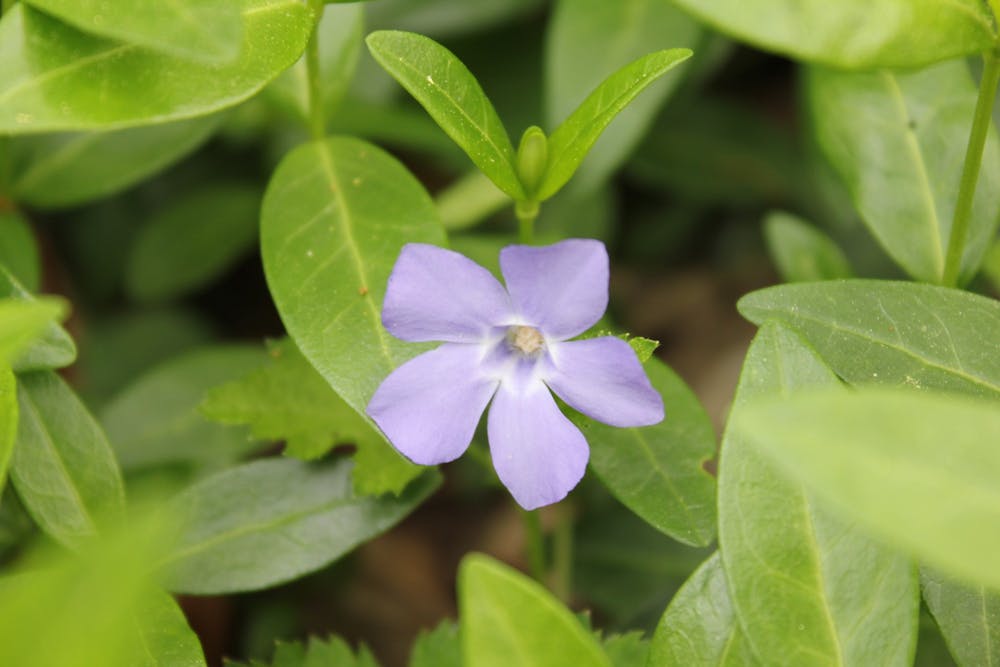With temperatures getting warmer and days growing longer, plants have begun to bloom around Grounds and in the local Charlottesville area. Pollinators, such as bees, are also making appearances. For those interested in spending time outdoors and seeing spring in all its colorful and dynamic glory, there are several sights to look out for.
Environmental sciences graduate student Amber Slatosky, who studies interactions between bees and a parasitic fly, discussed some trees and plants that can be seen around Grounds.
“My favorite place to go up is up on O’Hill near the observatory,” Slatosky said. “And there's this full understory of periwinkle — [a] beautiful, beautiful field of purple flowers — and there are just queen bumblebees cruising everywhere.”
Slatosky also mentioned that redbud trees are present around Grounds and are often teeming with bees at this time of year. The trees are part of the legume family and display brightly colored flowers before having leaves.
Dr. T’ai Roulston, research associate professor and curator of the University’s Blandy Experimental Farm, emphasized the importance of redbud trees to pollinators.
“If there's one plant in the spring that really is an anchor for at least all the species of bee pollinators, it really is redbud,” Roulston said.
Bumblebees and carpenter bees are two types of bees that can commonly be sighted around Grounds and Charlottesville, according to Roulston.
“At this time of year, it's going to primarily be bumblebee queens … and the first workers will be coming out so bumblebees are very prominent right now,” Roulston said. “There are other pollinator species that people see prominently — carpenter bees would be one that everybody notices now as the males are hovering in front of people's faces and driving them crazy, holding their aerial territories.”
However there are also several other types of bees that are found in the area, including mason bees, leaf-cutter bees, sweat bees and cellophane bees, Roulston and Slatosky said.
Roulston mentioned that the area around Clark Hall is home to many types of plants and bees prominently seen at this time, adding that much of Grounds has sights to enjoy.
“The campus is very nicely planted and so it is convenient that some of the trees are labeled in places — you can kind of learn what some of them are,” Roulston said.
For those who want to venture outside of Grounds, Washington Park — located off of Preston Avenue — is a great spot, according to Environmental Sciences graduate student Emily Spindler.
“They have this really amazing pollinator garden and they have a big structure in the middle that's actually just full of bee hotels,” Spindler said. “They've got all kinds of plants in there that are labeled, too, that will tell you what plants they are and who they're important for.”
Bee hotels are structures that invite solitary bees — those that live alone rather than in hives — to lay their eggs.
Located just north of the University, Ivy Creek Foundation is another spot to see flowers and their pollinators.
“That place is great because it's so convenient and because you've got that variety of habitat, you're more likely to see a diversity of either flowering species or pollinators,” Environmental Sciences graduate student Kelsey Schoenemann said.
The University’s own Student Garden, located at the intersection of Alderman and McCormick Road, is another convenient location for University members to see plants and pollinators. A new student organization that Spindler and Schoenemann started called Bee Grounds will soon plant pollinator-attracting plants there, Spindler said. Currently, Bee Grounds is nestled under the Environmental Stewardship Subcommittee of U.Va. Sustainability.
Spindler said that she first heard about the opportunity through the Xerces Society, which encourages pollinator conservation by offering universities to apply to become a Bee Campus via certification. Currently, 115 colleges and universities are Bee Campus affiliates.
Schoenemann said that Spindler came to her with the idea first, piquing her interest with the idea of grassroots conservation.
“I just really got interested in how private citizens could contribute to the conservation of pollinators because up until then, I really thought about the Fish and Wildlife Service or other state agencies that are responsible for natural resources,” Schoenemann said.
The group currently consists of the two graduate students and two undergraduates and meets virtually once a week.
“We're trying to educate not only our U.Va. community but hopefully the broader Charlottesville community, too, about why pollinators are so important and that they could be in decline,” Spindler said regarding the goals of Bee Grounds.
Roulston said that bee populations are in decline due to a variety of complicated factors, though more specific data is still being collected to better understand the problem.
“We don't have surveys within Charlottesville from 20 years ago to compare with now to say exactly what's going on in Charlottesville, but what I can say is that there are quite a number of species across the country that are clearly declining across their whole range,” Roulston said.
Slatosky said that the rusty patched bumblebee is one species that was once prevalent in Charlottesville and throughout the East Coast but is now dwindling.
“It's an example of a bee whose range has collapsed and it's actually now considered threatened or endangered,” Slatosky said.
Roulston said that climate change could be part of the reason that bees’ ranges are shrinking. However, there are other factors that are also likely contributing to the declines.
“There are some species that seem to be affected by climate change, ones that seem to be losing the southern part of their range because it starts to get too warm for them,” Roulston said. “I would say that the suite of disease, pesticides, and loss of habitat is frequently the most important combination of stressors that seem to be involved.”
Schoenemann mentioned that warmer temperatures are potentially affecting plants as well.
“[A pollinator researcher] posted about the first date where they saw their willow trees blooming, and they recorded the first date for the last four years,” Schoenemann said. “It's advanced by like a week or two in that span, so I see indirect evidence of things getting warmer, plants emerging sooner.”
Emerging prematurely due to warmer temperatures could potentially lead to certain crops suffering from later freezes if winter is not over as well as not accumulating enough cold to blossom in the spring.
One factor that likely does not affect pollinators and the plants they visit is cicadas, which are now emerging in large numbers in the mid-Atlantic after a hiatus of 17 years.
“I would not really expect [cicadas] to interact or impact pollinators very much because the adults that we see flying around aren't feeding at all, they're not eating anything,” Schoenemann said. “They're just finding mates and then laying their eggs.”
For those interested in doing more than enjoying spring’s views, Slatosky and Spindler offered several ideas for helping out plants and pollinators.
Slatosky suggested the book “Piedmont Native Plants” for learning about both plants and pollinators.
“In it, they have all kinds of information about [the] Virginia Native Plant Society, they have places where you can buy native plants and they have ideas for how to stagger the flowering season in your yard for pollinators,” Slatosky said.
Spindler added that individuals can partake in citizen science by making observations about their outdoor sightings on mobile apps such as iNaturalist.
“It's a really neat opportunity to just be able to start making observations ... that can be accumulated to make the kind of datasets that we need to have information about the health of our pollinator communities,” Spindler said.
Slatosky also encouraged people to start by observing bees, especially those who are afraid of them.
“Just sit there, enjoy the beautiful flowers and watch [the queen] go about her work,” Slatosky said. “Watch her go about gathering food for her young. And just see bees in action — start there and then ask questions.”






